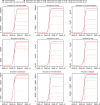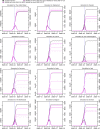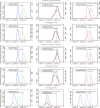SARS-Cov-2 trajectory predictions and scenario simulations from a global perspective: a modelling study
- PMID: 33110114
- PMCID: PMC7591883
- DOI: 10.1038/s41598-020-75332-x
SARS-Cov-2 trajectory predictions and scenario simulations from a global perspective: a modelling study
Abstract
The coronavirus SARS-CoV-2 emerging from Wuhan, China has developed into a global epidemic. Here, we combine both human mobility and non-pharmaceutical interventions (social-distancing and suspected-cases isolation) into SEIR transmission model to understand how coronavirus transmits in a global environment. Dynamic trends of region-specific time-variant reproduction number, social-distancing rate, work-resumption rate, and suspected-cases isolation rate have been estimated and plotted for each region by fitting stochastic transmission processes to the real total confirmed cases reported of each region. We find after shutdown in Wuhan, the reproduction number in Wuhan greatly declined from 6·982 (95% CI 2·558-14·668) on January 23rd, 2020 to 1.130 (95% CI 0.289-3.279) on February 7th, 2020, and there was a higher intervention level in terms of social-distancing and suspected-cases isolation in Wuhan than the Chinese average and Western average, for the period from the shutdown in Wuhan to mid-March. Future epidemic trajectories of Western countries up to October 10th, 2020, have been predicted with 95% confidence intervals. Through the scenario simulation, we discover the benefits of earlier international travel ban and rigorous intervention strategies, and the significance of non-pharmaceutical interventions. From a global perspective, it is vital for each country to control the risks of imported cases, and execute rigorous non-pharmaceutical interventions before successful vaccination development.
Conflict of interest statement
The authors declare no competing interests.
Figures









References
-
- Yang, Y. G. The orderly resumption of work and production in China is encouraging. China Radio International Online Network.https://news.cri.cn/20200420/a6096eb4-fde9-b286-f082-805b6adc6af0.html (2020).
Publication types
MeSH terms
Grants and funding
- 71974011/National Natural Science Foundation of China/International
- 71972012/National Natural Science Foundation of China/International
- 71804009/National Natural Science Foundation of China/International
- 17JDGLB008/Beijing Social Science Fund/International
- 17GLC043/Beijing Social Science Fund/International
LinkOut - more resources
Full Text Sources
Miscellaneous

